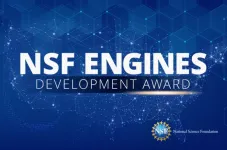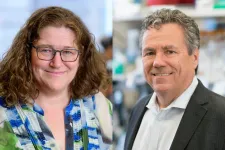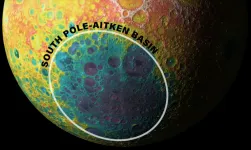(Press-News.org) Sometimes life’s most meaningful relationships grow from the briefest of connections. Like when you go to a party and meet someone wearing your favorite band’s T-shirt, or who laughs at the same jokes as you, or who grabs that unpopular snack you alone (or so you thought) love. One small, shared interest sparks a conversation—that’s my favorite, too!—and blossoms into lasting affection.
This is called the similarity-attraction effect: we generally like people who are like us. Now, new findings from a Boston University researcher have uncovered one reason why.
In a series of studies, Charles Chu, a BU Questrom School of Business assistant professor of management and organizations, tested the conditions that shape whether we feel attracted to—or turned off by—each other. He found one crucial factor was what psychologists call self-essentialist reasoning, where people imagine they have some deep inner core or essence that shapes who they are. Chu discovered that when someone believes an essence drives their interests, likes, and dislikes, they assume it’s the same for others, too; if they find someone with one matching interest, they reason that person will share their broader worldview. The findings were published in the American Psychological Association’s Journal of Personality and Social Psychology.
“If we had to come up with an image of our sense of self, it would be this nugget, an almost magical core inside that emanates out and causes what we can see and observe about people and ourselves,” says Chu, who published the paper with Brian S. Lowery of Stanford Graduate School of Business. “We argue that believing people have an underlying essence allows us to assume or infer that when we see someone who shares a single characteristic, they must share my entire deeply rooted essence, as well.”
But Chu’s research suggests this rush to embrace an indefinable, fundamental similarity with someone because of one or two shared interests may be based on flawed thinking—and that it could restrict who we find a connection with. Working alongside the pull of the similarity-attraction effect is a countering push: we dislike those who we don’t think are like us, often because of one small thing—they like that politician, or band, or book, or TV show we loathe.
“We are all so complex,” says Chu. “But we only have full insight into our own thoughts and feelings, and the minds of others are often a mystery to us. What this work suggests is that we often fill in the blanks of others’ minds with our own sense of self and that can sometimes lead us into some unwarranted assumptions.”
Trying to Understand Other People
To examine why we’re attracted to some people and not to others, Chu set up four studies, each designed to tease out different aspects of how we make friends—or foes.
In the first study, participants were told about a fictional person, Jamie, who held either complementary or contradictory attitudes to them. After asking participants their views on one of five topics—abortion, capital punishment, gun ownership, animal testing, and physician-assisted suicide—Chu asked how they felt about Jamie, who either agreed or disagreed with them on the target issue. They were also quizzed about the roots of their identity to measure their affinity with self-essentialist reasoning.
Chu found the more a participant believed their view of the world was shaped by an essential core, the more they felt connected to the Jamie who shared their views on one issue.
In a second study, he looked at whether that effect persisted when the target topics were less substantive. Rather than digging into whether people agreed with Jamie on something as divisive as abortion, Chu asked participants to estimate the number of blue dots on a page, then categorized them—and the fictional Jamie—as over- or under-estimators. Even with this slim connection, the findings held: the more someone believed in an essential core, the closer they felt to Jamie as a fellow over- or under-estimator.
“I found that both with pretty meaningful dimensions of similarity as well as with arbitrary, minimal similarities, people who are higher in their belief that they have an essence are more likely to be attracted to these similar others as opposed to dissimilar others,” says Chu.
In two companion studies, Chu began disrupting this process of attraction, stripping out the influence of self-essentialist reasoning. In one experiment, he labeled attributes (such as liking a certain painting) as either essential or nonessential; in another, he told participants that using their essence to judge someone else could lead to an inaccurate assessment of others.
“It breaks this essentialist reasoning process, it cuts off people’s ability to assume that what they’re seeing is reflective of a deeper similarity,” says Chu. “One way I did that was to remind people that this dimension of similarity is actually not connected or related to your essence at all; the other way was by telling people that using their essence as a way to understand other people is not very effective.”
Negotiating Psychology—and Politics—at Work
Chu says there’s a key tension in his findings that shape their application in the real world. On the one hand, we’re all searching for our community—it’s fun to hang out with people who share our hobbies and interests, love the same music and books as us, don’t disagree with us on politics. “This type of thinking is a really useful, heuristic psychological strategy,” says Chu. “It allows people to see more of themselves in new people and strangers.” But it also excludes people, sets up divisions and boundaries—sometimes on the flimsiest of grounds.
“When you hear a single fact or opinion being expressed that you either agree or disagree with, it really warrants taking an additional breath and just slowing down,” he says. “Not necessarily taking that single piece of information and extrapolating on it, using this type of thinking to go to the very end, that this person is fundamentally good and like me or fundamentally bad and not like me.”
Chu, whose background mixes the study of organizational behavior and psychology, teaches classes on negotiation at Questrom and says his research has plenty of implications in the business world, particularly when it comes to making deals.
“I define negotiations as conversations, and agreements and disagreements, about how power and resources should be distributed between people,” he says. “What inferences do we make about the other people we’re having these conversations with? How do we experience and think about agreement versus disagreement? How do we interpret when someone gets more and someone else gets less? These are all really central questions to the process of negotiation.”
But in a time when political division has invaded just about every sphere of our lives, including workplaces, the applications of Chu’s findings go way beyond corporate horse trading. Managing staff, collaborating on projects, team bonding—all are shaped by the judgments we make about each other. Self-essentialist reasoning may even influence society’s distribution of resources, says Chu: who we consider worthy of support, who gets funds and who doesn’t, could be driven by “this belief that people’s outcomes are caused by something deep inside of them.” That’s why he advocates pushing pause before judging someone who, at first blush, doesn’t seem like you.
“There are ways for us to go through life and meet other people, and form impressions of other people, without constantly referencing ourselves,” he says. “If we’re constantly going around trying to figure out, who’s like me, who’s not like me?, that’s not always the most productive way of trying to form impressions of other people. People are a lot more complex than we give them credit for.”
END
The science of attraction: why do we fall for certain people?
A series of Boston University–led studies found people who believe they have a core essence that drives their likes and dislikes were more likely to be drawn to people with similar interests
2023-05-11
ELSE PRESS RELEASES FROM THIS DATE:
Estimated annual spending on Lecanemab and its ancillary costs in the Medicare program
2023-05-11
About The Study: Lecanemab and associated ancillary services could add an estimated $2 billion to $5 billion annually to Medicare spending with substantial out-of-pocket costs for beneficiaries lacking supplemental coverage, according to a cost analysis using nationally representative survey data. Lecanemab, an antidementia medication with modest clinical benefit, received accelerated Food and Drug Administration approval.
Authors: John N. Mafi, M.D., M.P.H., of the David Geffen School of Medicine at the University of California, Los Angeles, is the corresponding ...
Kentucky, Tennessee GAME Change team wins NSF Engines Development Award
2023-05-11
LEXINGTON, Ky. (May 11, 2023) — The University of Kentucky, as lead organization, together with partners across Kentucky and Tennessee, has been awarded $1 million from the U.S. National Science Foundation’s Regional Innovation Engines, or NSF Engines, program. This team’s proposal, “Advancing carbon centric circular economy technologies for advanced manufacturing solutions (KY, TN),” is led by a coalition named Generate Advanced Manufacturing Excellence for Change (GAME Change).
The GAME Change team is among the more than 40 unique teams to receive one of the first-ever NSF Engines ...
Study could help solve mystery of the disappearing twins
2023-05-11
Key takeaways
UCLA and Keck Observatory scientists analyzed over a decade’s worth of data about 16 young supermassive stars orbiting the supermassive black hole at the center of the Milky Way galaxy.
Supermassive stars typically are formed in pairs, but the new study found that all 16 of the stars were singletons.
The findings support a scenario in which the supermassive black hole drives nearby stars to either merge or be disrupted, with one of the pair being ejected from the system.
When supermassive stars are born, they’re almost always paired ...
Expansion of cell-to-cell communication drives the early development of pancreatic cancer, new research in mice finds
2023-05-11
Discussions of cancer often stress the genetic mutations that drive disease by altering the normal function of cellular proteins. KRAS, for example, normally acts as an on/off switch for cellular proliferation, but mutations to the gene — common in lung cancer, colorectal cancer and pancreatic cancer — cause that switch to stay on.
Yet mutations are only half of the story.
Interactions between these genetic mutations and external factors, such as tissue injury that leads to inflammation, reshape both cells’ identities and their local environment in ways that foster cancer’s emergence and runaway growth.
In pancreatic cancer, these changes start ...
When stem cells can’t roll on a bumpy road, muscles break down
2023-05-11
Key takeaways
Stem cells travel along a collagen network to reach damaged muscle tissue and heal it.
In Duchenne muscular dystrophy, stiff, scarred collagen prevents stem cells from reaching their target.
A protein called sarcospan lessens this scarring and allows stem cells to do their job more successfully, pointing toward potential new treatments for the disorder.
Muscles that ache after a hard workout usually don’t hurt for long, thanks to stem cells that rush to the injured site along “collagen highways” within the muscle and repair the damaged tissue. ...
SwRI to lead NASA/SSERVI Center for Lunar Origin and Evolution
2023-05-11
SAN ANTONIO — May 11, 2023 —Southwest Research Institute has entered into a five-year, $7.5-million cooperative agreement with NASA to lead the Center for Lunar Origin and Evolution (CLOE), which will conduct basic research to support science enabled by human exploration of the Moon and the Endurance-A mission concept, a far side lunar rover mission prioritized by the 2022 Planetary Science and Astrobiology Decadal Survey report, “Origins, Worlds, and Life.” CLOE will be part of NASA’s Solar System Exploration Research Virtual Institute (SSERVI).
“The Moon is unmatched in its potential to provide ...
Google Quantum AI braids non-Abelian anyons for the first time
2023-05-11
Our intuition tells us that it should be impossible to see whether two identical objects have been swapped back and forth, and for all particles observed to date, that has been the case. Until now.
Non-Abelian anyons - the only particles that have been predicted to break this rule - have been sought for their fascinating features and their potential to revolutionize quantum computing by making the operations more robust to noise. Microsoft and others have chosen this approach for their quantum computing effort. But after decades of efforts by researchers in the field, observing non-Abelian anyons and their strange behavior has proven challenging, ...
Solar-powered balloons detect mysterious sounds in the stratosphere #ASA184
2023-05-11
CHICAGO, May 11, 2023 – Imagine if sending your science experiment 70,000 ft in the air just took painter’s plastic, tape, a dash of charcoal dust, and plenty of sunlight.
Daniel Bowman of Sandia National Laboratories will present his findings using solar-powered hot air balloons to eavesdrop on stratospheric sounds at the upcoming 184th Meeting of the Acoustical Society of America, running May 8-12 at the Chicago Marriott Downtown Magnificent Mile Hotel. His presentation will take place Thursday, May 11, at 2:50 p.m. Eastern U.S. in the Purdue/Wisconsin ...
Earth system modeling and fossil data reveal Homo adaptation to diverse environments
2023-05-11
Homo species – particularly Homo sapiens – were uniquely equipped to adapt to highly diverse environmental conditions and landscape mosaics, according to a new study, which may have enabled our species and that of our closely related ancestors to survive and thrive in highly fluctuating Pleistocene environments. Homo sapiens are the only surviving hominin species today. However, whether this is because our species was uniquely successful at adapting to Pleistocene environments, because we outcompeted other contemporary Homo species through unique physiological or social adaptations, ...
A better route to benzocyclobutenes, sought-after buildingblocks for drugs
2023-05-11
LA JOLLA, CA— Scripps Research chemists have solved a long-standing problem in the field of pharmaceutical chemistry with a relatively simple and controllable method for making benzocyclobutenes (BCBs)—a class of reactive compounds that are highly valued as building blocks for drug molecules, but have been relatively hard to access.
The new method, described in a paper in Science on May 12, uses designer ligand molecules with palladium-atom catalysts to break pairs of adjacent methylene-type C-H bonds in relatively cheap and abundant carboxylic acids. Breaking these bonds enables the making ...
LAST 30 PRESS RELEASES:
New study highlights link between eviction rates and gun violence
Heatwaves heat up soil but not toxin levels in rice, study finds
Digital modeling reveals where construction carbon emissions really come from
Turning farm waste into water filters
New study shows how the spleen helps the immune system accept a transplant
New Mayo Clinic study advances personalized prostate cancer education with an EHR-integrated AI agent
Researchers identify novel therapeutic target to improve recovery after nerve injury
Microbes in breast milk help populate infant gut microbiomes
Reprogramming immunity to rewrite the story of Type 1 diabetes
New tool narrows the search for ideal material structures
Artificial saliva containing sugarcane protein helps protect the teeth of patients with head and neck cancer
Understanding the role of linear ubiquitination in T-tubule biogenesis
Researchers identify urban atmosphere as primary reservoir of microplastics
World’s oldest arrow poison – 60,000-year-old traces reveal early advanced hunting techniques
Bristol scientists discover early sponges were soft
New study uncovers how rice viruses manipulate plant defenses to protect insect vectors
NSF–DOE Vera C. Rubin Observatory spots record-breaking asteroid in pre-survey observations
Ribosomal engineering creates “super-probiotic” bacteria
This self-powered eye tracker harnesses energy from blinking and is as comfortable as everyday glasses
Adverse prenatal exposures linked to higher rates of mental health issues, brain changes in adolescents
Restoring mitochondria shows promise for treating chronic nerve pain
Nature study identifies a molecular switch that controls transitions between single-celled and multicellular forms
USU chemists' CRISPR discovery could lead to single diagnostic test for COVID, flu, RSV
Early hominins from Morocco reveal an African lineage near the root of Homo sapiens
Small chimps, big risks: What chimps show us about our own behavior
We finally know how the most common types of planets are created
Thirty-year risk of cardiovascular disease among healthy women according to clinical thresholds of lipoprotein(a)
Yoga for opioid withdrawal and autonomic regulation
Gene therapy ‘switch’ may offer non-addictive pain relief
Study shows your genes determine how fast your DNA mutates with age
[Press-News.org] The science of attraction: why do we fall for certain people?A series of Boston University–led studies found people who believe they have a core essence that drives their likes and dislikes were more likely to be drawn to people with similar interests





